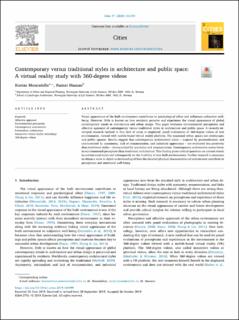Contemporary versus traditional styles in architecture and public space: A virtual reality study with 360-degree videos
Peer reviewed, Journal article
Published version

Permanent lenke
https://hdl.handle.net/11250/2823394Utgivelsesdato
2020Metadata
Vis full innførselSamlinger
Originalversjon
10.1016/j.cities.2019.102499Sammendrag
Visual appearance of the built environment contributes to psychological affect and influences subjective well-being. However, little is known on how residents perceive and experience the visual appearance of global contemporary trends in architecture and urban design. This paper evaluates environmental perceptions and affective appraisal of contemporary versus traditional styles in architecture and public space. A recently-developed research method in this field of study is employed: panel evaluations of 360-degree videos of real environments, viewed with mobile-based virtual reality platform. The examined urban spaces are streetscapes and public squares. Results suggest that contemporary architectural styles – inspired by postmodernism and characterized by asymmetry, lack of ornamentation, and industrial appearance – are evaluated less positively than traditional styles – characterized by symmetry and ornamentation. Contemporary architecture scores lower in environmental perception than traditional architecture. This finding poses critical questions on current trends in architectural styles and subsequently on the livability of new built environments. Further research is necessary to obtain a more in-depth understanding of how the detailed physical characteristics of architecture contribute to perceptions and emotional well-being.